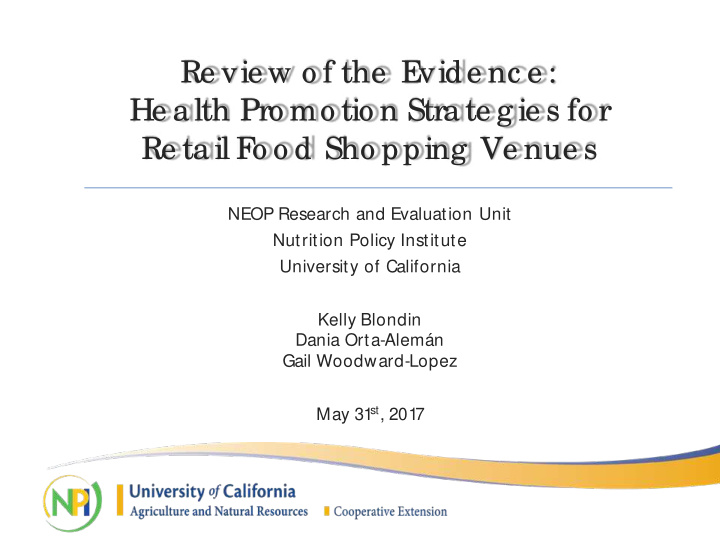



Re vie w o f the E vide nc e : He a lth Pro mo tio n Stra te g ie s fo r Re ta il F o o d Sho pping Ve nue s NEOP Research and Evaluation Unit Nutrition Policy Institute University of California Kelly Blondin Dania Orta-Alemán Gail Woodward-Lopez st , 201 May 31 7
Healthy Retail S hopping Patterns and Potential Reach
L o w-inc o me individua ls tra ve l to sho p a t full se rvic e ma rke ts • On average SNAP recipients travel 3.8 miles to their primary grocery store – Closest SNAP-authorized store is 2.0 miles away Ver Ploeg M, et al., 2015. Where do Americans usually shop for food and how do they travel to get there? Initial findings from the national household food acquisition and purchase survey.
Whe re do SNAP Pa rtic ipa nts Sho p? Specialty stores, 1.1% Convenience stores, 5.0% Farmers' Markets, 0.5% Grocery stores, 4.7% Supermarkets, 42.6% Supercenters, 41.5% Castner L, Henke J. Benefit Redemption Patterns in the S upplemental Nutrition Assistance Program : Mathematica Policy Research; 2011
Co nc lusio ns: Sho pping Pa tte rns • Income more predictive than access • SNAP households shop at low-cost venues and will travel to do so • But still challenged to purchase a healthful product mix – Low-income households may stretch limited dollars by purchasing lower cost, less healthy foods • A small proportion of households have extremely limited access to healthy full service outlets
Healthy Retail What works ?
Me tho ds Systematic literature review • Interventions implemented via retail food stores that sell unprepared food. • Pre/post measures with control group • Outcome measures: food purchases , dietary intake , and/or adiposity • Upper-Middle or High-Income countries Databases: PubMed and agency repositories • 88 primary papers • Published between 1 982 to present, most from later 1 990s on
Sto re -b a se d Pric e Ac c e ss inte rve ntio ns inte rve ntio ns inte rve ntio ns • Printed promotional • Opening new • Vouchers/Coupons materials supermarkets in • Vouchers+Nut Education • In-store nutrition education undeserved areas • Rebates • Store conversions • Free produce delivery • Discounts • Product placement, • Taxes improved stocking, training to store owners, taste-tests
1. Ac c e ss inte rve ntio ns • Opening new stores : No promise • Delivering free produce : shows promise but more evidence is needed
Ca se in Point: F o o d De live ry n I nte rve ntio n: “ Ro lling Sto re " fo o d d e live ry and nutritio n e d uc atio n fo r n Afric an Ame ric an w o me n n Study De sig n: RCT n Bato n Ro ug e , L A n n I mpa c t: Sig nific antly inc re ase d c o nsumptio n o f fruit, fruit juic e and n ve g e table s (se rving s/ day) Me an de c re ase in we ig ht o f 0.4kg (SD 3.0kg ), and re duc e d BMI n at 6 m o nths. (Source: Kennedy et al., 2009)
2. Sto re -Ba se d inte rve ntio ns • Nutrition education and promotion via print materials or audio-visual mediums: not consistently effective • Multicomponent store interventions: Not consistently effective
Ca se in Point: Gro c e ry Cart Plac ards • Intervention: § Placards on shopping carts with a message about the number of produce items normally purchased § Focus on social norms • Study Design: § Quasi-experiment § 1 intervention and 1 control supermarket in El Paso, TX • Impact § Increased produce spending after 2 weeks (p=0.04) (Source: Payne et al., 201 5)
Ca se in Point: E at Rig ht-L ive We ll Intervention: n Increased stocking of healthy foods n Shelf labels and signage for n promoted healthier foods Taste tests n Store staff training. n Community outreach events n Study Design: n Quasi-experiment, 4 months n 2 supermarkets n Baltimore, MD n Impact: n Increased sales of promoted healthier foods (low-fat, low-sodium, healthier n sugar level, 1 00% juice) in the intervention store. (Source: Surkan et al., 201 6)
3. Pric e inte rve ntio ns • Monetary incentives, including vouchers, coupons, rebates and price reductions: Consistently effective • Taxes : Promising approach
Ca se in Point: SNAP He althy Inc e ntive Pilo t § Intervention: • Incentive of 30 cents for every $1 of fruits and vegetables purchased • Up to $60/month, added to EBT card § Study Design: • RCT, 23 months • SNAP-authorized retailers in western MA § Impact: • 26% increase in consumption of FVs • About ¼ cup or ½ serving/day (Source: Bartlett et al., 2014 (USDA Report))
Co nc lusio ns • Promising evidence: Price interventions (vouchers/coupons, rebates, price reductions, monetary incentives) • Inconsistent evidence: Store-based interventions (in-store print materials, audio-visual education, multicomponent) • Insufficient evidence: Access interventions (new supermarkets, free produce delivery) • No evidence: farmers’ markets, food hubs, food coops, food banks, healthy checkouts, in-store availability of healthy and/or unhealthy products, among others.
Recommend
More recommend